My Dad was always a keen photographer. When he bought his Zeiss Ikon Ikonta in the early 1950s, it would have been a substantial outlay for him as a civil servant.
While he didn’t opt for the Super Ikonta, he paid for a few optional extras; a leather case, the 75mm 3.5 Tessar lens and Compur shutter which had a blindingly fast 1/500th maximum speed! In those days, the purchase of a camera was a once in a lifetime buy and intended to last until the end of your days. That’s the way a lot of things were built back then and given the issues we face today in terms of resource use and sustainability – maybe we should be looking back in that direction again. When I look at cameras from the 50’s, 60’s and 70’s and then look at my Nikon D750 – I’m fairly sure that it won’t be functioning 70 years from now. I recently wrote an article about the Minolta XE1 – this camera and others from the same era were built to last generations.
Not that many people had a good camera in the 1950’s and 60’s and my Dad quickly became the family photographer; shooting weddings and family get-togethers. When he met my mother shortly after buying the camera, he moved his attention to photographing his future wife. When I discovered a folder full of 120 negatives and scanned them, I was stunned at the quality of some of the photos that he had taken and the fact that the negatives had survived so well for over 60 years.
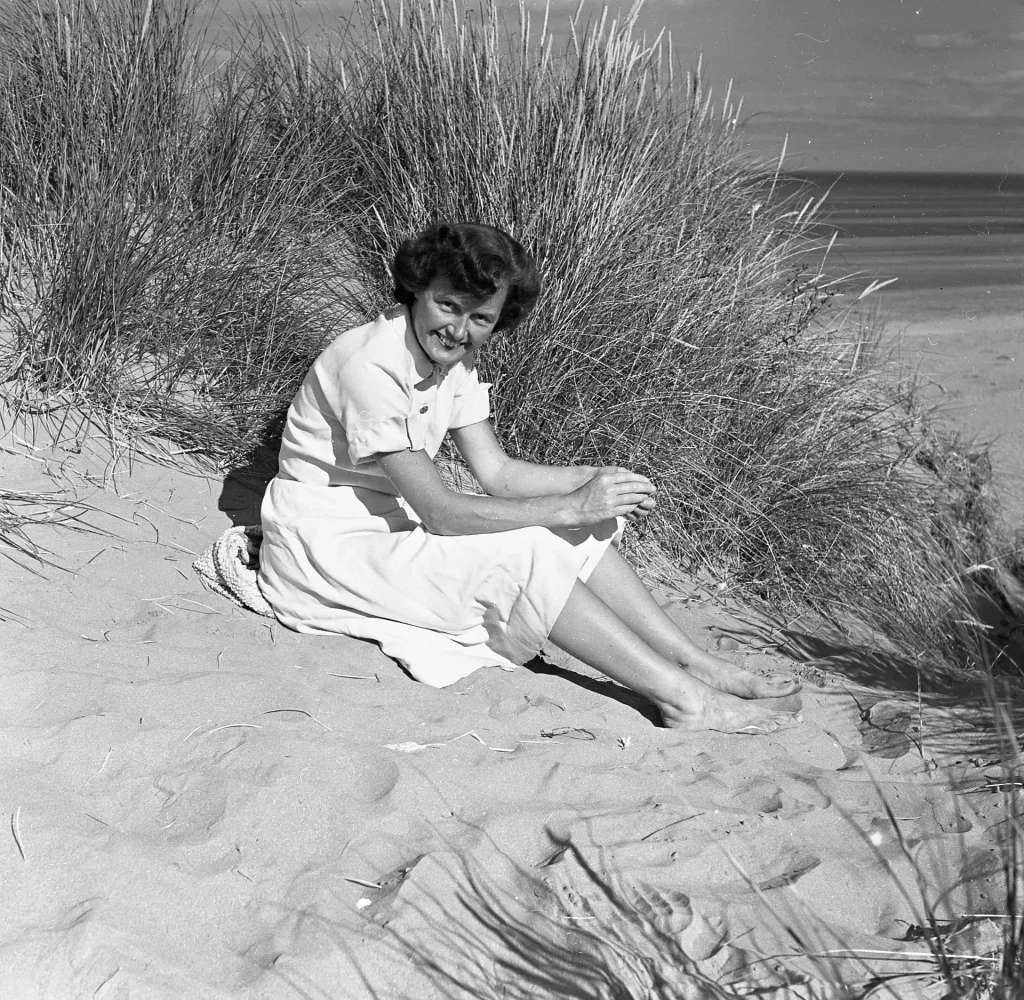
Photography was part of my upbringing in the 70’s. My Dad and my eldest brother were keen photographers and being the youngest of five boys, I would look on in wonder at my Dad’s Zeiss Ikon Ikonta and the processing and printing equipment they used. When I get a whiff of photography chemicals these days, it still brings me back nearly fifty years to the alchemy that went on in the living room that was temporarily blacked out and set up for a processing and printing session.
I was five years old when my Dad died. It was devastating to my mother and brothers – I was too young to realise what was going on and while a lot of things got turned upside down in our lives, photography remained part of the make-up of our lives with my eldest brother taking over my Dad’s Zeiss and processing/printing equipment.
As a kid, I couldn’t wait until I got my hands on a camera and at the ripe old age of 10, I persuaded my mother to give me her Kodak X15F for a school trip. It took a 126 film cartridge and I shot a roll of truly awful photos – but was absolutely hooked. A few years later, when I was 15, my brother decided to move on to an Olympus SLR and he handed over the Zeiss and the film developing equipment to me. The camera was literally a family heirloom and the only item I had that had belonged to my father. It was over 30 years old at this stage, but was still in pristine condition. I learned how to use the camera and my brother showed me how to process and print my own photos – I was on my way. I used the Zeiss for the next 8 or 9 years, but its usage waned when I got my first SLR – a Minolta 7000AF – the contrast with the Zeiss couldn’t have been any greater.
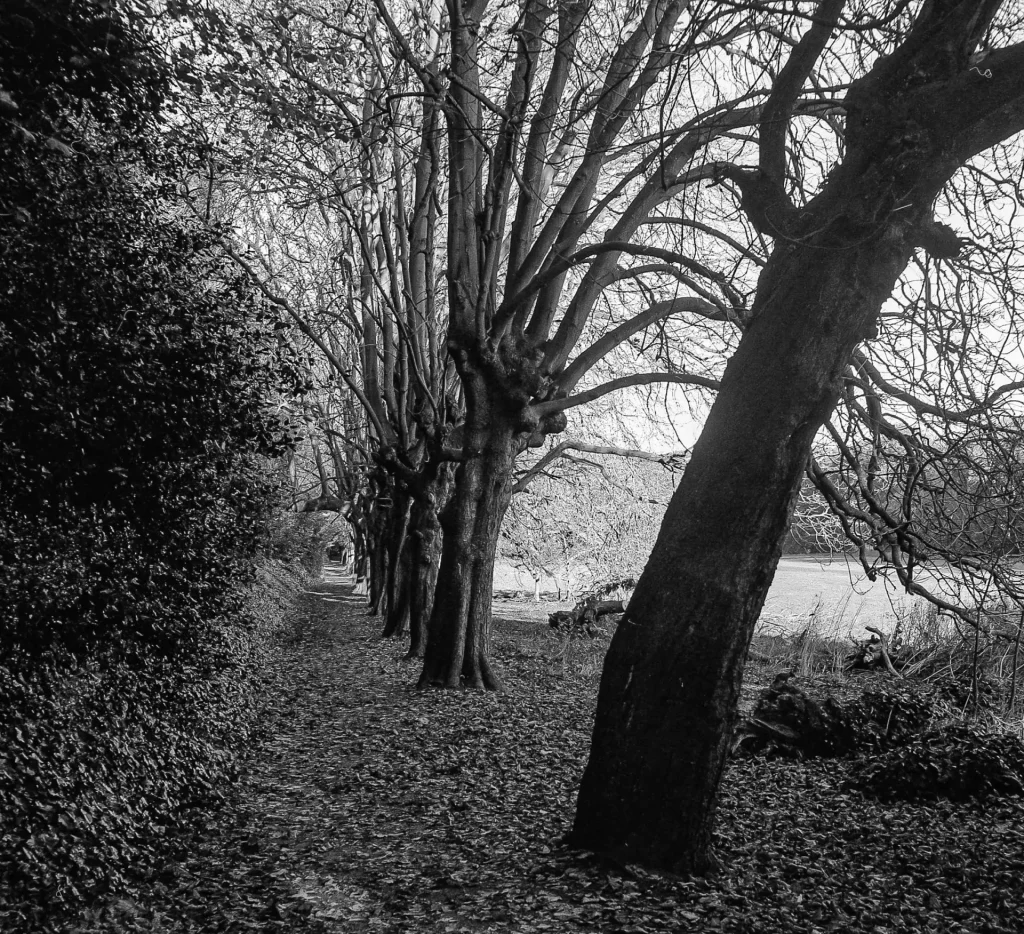
While the Zeiss remained a very precious item to me, it spent the next 2-3 years of the early 90’s carefully stored with a Weston Lightmeter in a drawer. In the early 1990’s shortly before getting married, our home was burgled and I had not only lost my Minolta 7000, but to my horror, the thief had also stolen the Zeiss Ikon. All the other items that were stolen that day paled into insignificance in comparison to the Zeiss; it was irreplaceable. I was imagining the camera being chucked into a bin as the culprit realised that the ancient folding camera in the leather case was not worth selling on.
Over the following years, I regularly thought about the camera and how it might be replaced. I looked in 2nd hand and charity shops to see if I could spot a similar camera. With the advent of the internet, I started to check eBay on a regular basis to see if I could get my hands on something at least close to my Dad’s Zeiss. While there were plenty of Zeiss Ikon folders for sale, I didn’t see that many Zeiss Ikonta 523/16’s with a 75mm 3.5 Tessar lens in an acceptable condition. I also kept an eye on the local, Irish online selling platform but rarely saw anything close to what I was looking for.
So – fast forward to 2021, seventy years after my Dad bought the camera and twenty-six years after it was stolen from my home, the rebirth of film had taken off a number of years earlier and by this time, I had developed a squirrel like obsession in collecting old film cameras. One day, while browsing the local online site, I see a Zeiss Ikon Ikonta for sale. When I went into the ad to look in a bit more detail, I see that it is a 523/16, it has a Tessar 75mm 3.5 lens and the Compur shutter. It also has a beautiful leather case. My heart starts beating a little faster as I realise that not only is this very similar to my Dad’s camera – it could well be the actual camera!
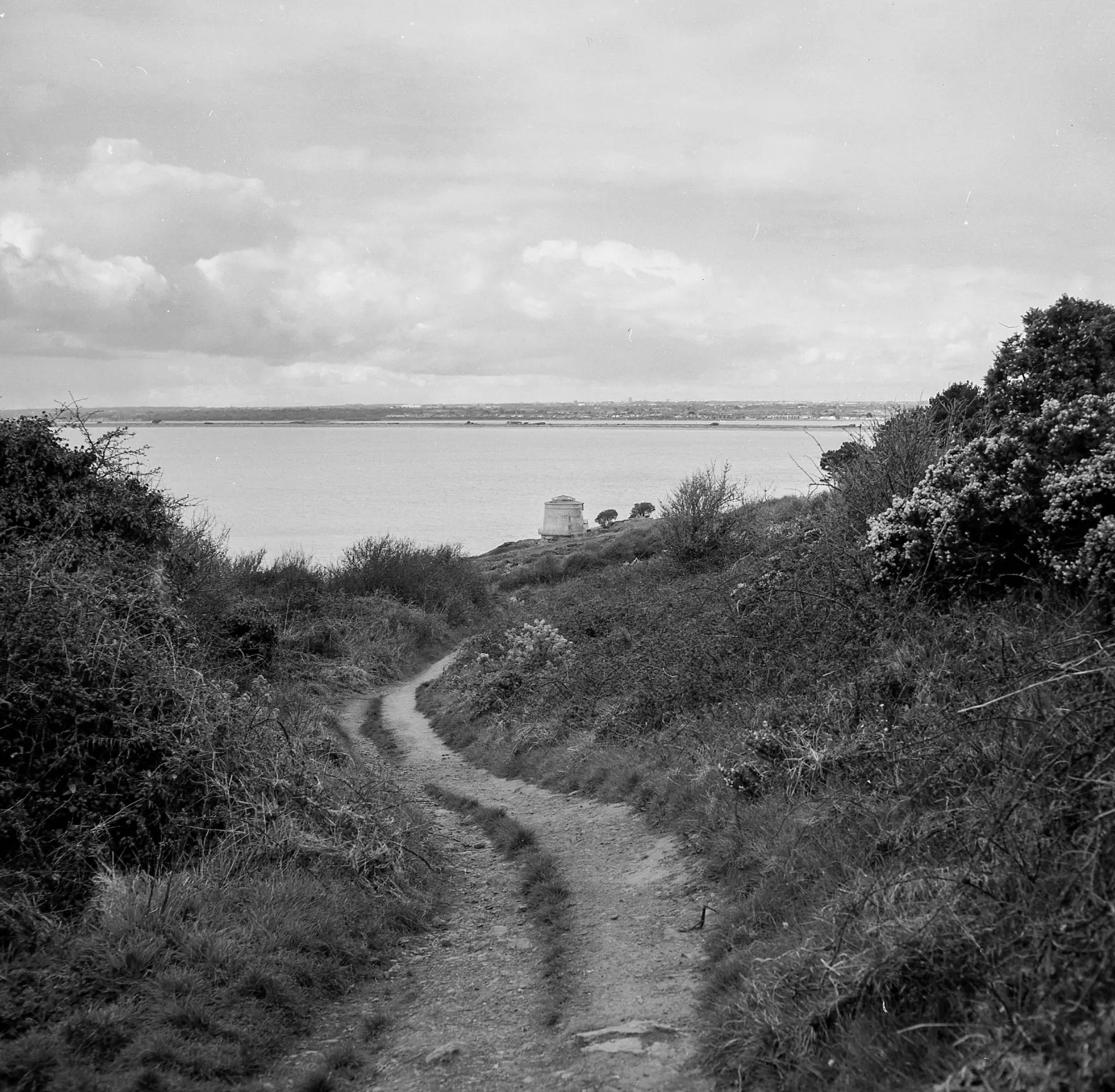
The seller had a price of €1 on the camera, which meant that he was open to offers. The camera looked in generally ok condition but I didn’t really care – I was buying this camera regardless of price. Much to my horror, while I was dithering over how much to offer, a bidder offered €40 for the camera and I immediately counter offered with €100 waiting to see if there would be a further counter bid….after a few minutes of manic refreshing of the page, all remained quiet….too quiet. You are able to see when the bidder was last online and I could see that they hadn’t been online since either bid. About every five minutes I returned to the page to see if the seller had been online or if there was going to be a counter-offer…..nothing. Eventually, a full day later, the seller accepted my offer and the following weekend I went to collect the camera. The minute I got it in my hands and opened it, I felt that it in my bones that this was the actual camera – there were giveaway signs like the DOF gauge being loose and the leather case gave me certainty that this was the one. The seller wasn’t able to offer any history of the previous twenty-six years, but I didn’t care – I was delighted to have it back in my hands; hardly able to believe my luck !
It was one thing getting the camera back, the next question was would it work? There was only one major problem that I could see – the shutter was stuck with the cocking lever on the lens stuck solid, other than that, it was cosmetically a little worse for wear with chips in the black enamel paint but generally not too bad.
I initially thought that just finding the camera would be enough, but the more I thought about it, the more I wanted to get the camera fixed and to use it again. I briefly (and naively) thought that I might repair it myself, but watching a few YouTube videos quickly dispensed with that idea; once I realised that my non-existent skills, deteriorating eyesight and banana fingers were going to struggle and likely finish off the camera for good. I was astounded at the complexity of the 70 year old machinery in the behind the shutter mechanism. I had to find someone to repair it for me and started to look online for who might be able to take it on. I saw one or two places in London, the US and Germany that specialised in vintage camera work and I even got a recommendation from Zeiss themselves who sent me a list of approved repair agents (I wasn’t even expecting a response, never mind a helpful one – very impressed!). In the end, I couldn’t bear to send it in a box out into the ether of the post/courier world only to possibly lose the camera again. I needed to get it repaired locally if possible and eventually I found a guy based in a small workshop in the south of Dublin who, much to my surprise, was willing to take it on. Over the next six weeks, there were a few nervous phone calls where the patient went in and out of ICU and it was definitely touch and go a few times, but eventually I got a call to say that the camera was in the post-op recovery room and I could collect the Zeiss.
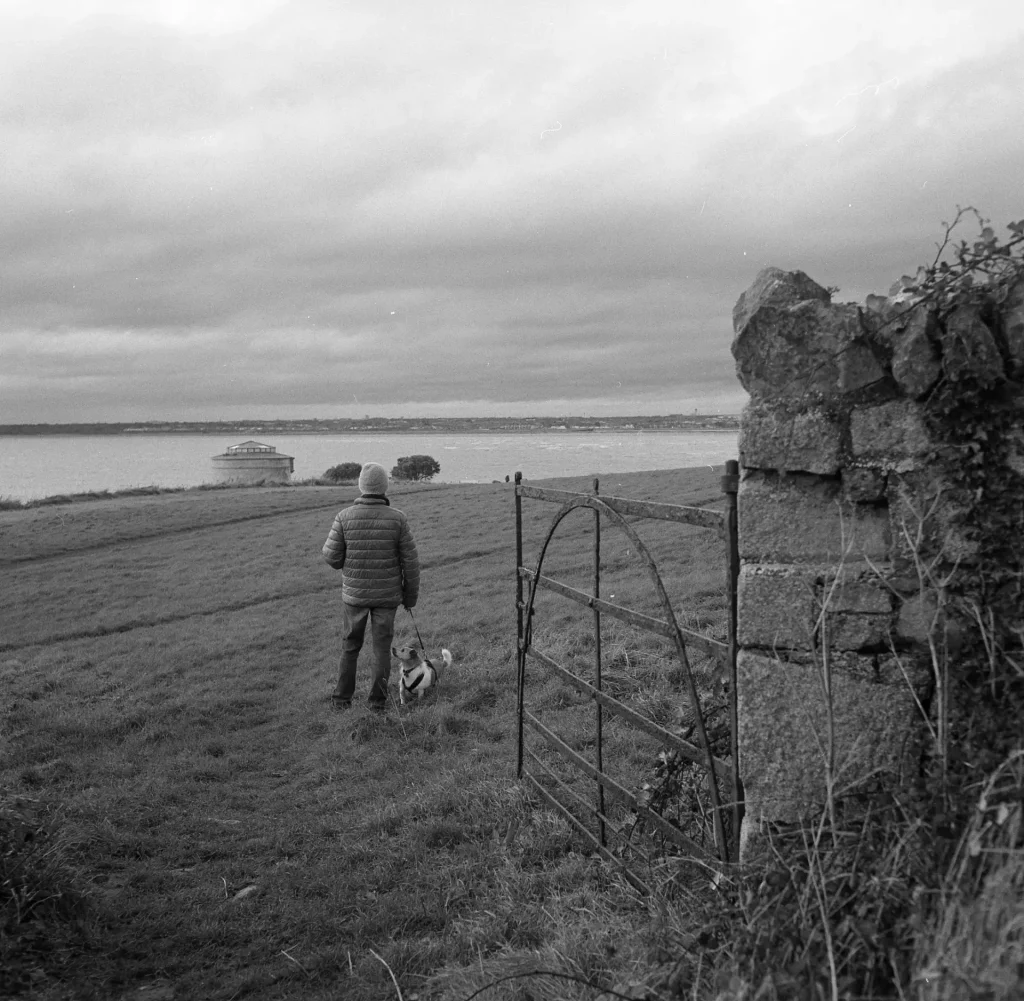
Now that the camera was functioning, I had to remember how to use it! I have spent the last twenty years being spoilt with digital cameras with variable ISO, auto-focus and increasingly forgiving dynamic range. The Zeiss Ikon Ikonta 523/16 is an entirely manual camera that takes 120 roll film, with no lightmeter and has manual focus – without a rangefinder or any visual means of setting focus other than through the use of the focus scale on the lens.
I located an online copy of the original manual and worked my way through the instructions to re-train myself on how to use the camera.
Once I had got my hands on a roll of 120 film, I had to figure out the negative format and how that worked. 120 roll film cameras can generally accommodate negative sizes of 6×4.5cm, 6x6cm, 6x7cm, 6x8cm, and 6x9cm depending on the camera. My Zeiss shot in 6x6cm which meant that I would get 12 shots out of a roll of film. What I was struggling to understand was how the negative numbers printed on the backing paper lined up with the little red window on the film door (that tells you when you have wound on the film to the next shot correctly) – in other words, how did the analogue camera connect with the analogue film backing paper to tell it what format it was shooting in ?? A little more research answered this for me and I discovered that the window was set on the film door according to the type of format you were shooing in – i.e for 6X6 format, the window is set in the middle of the film door. If my camera shot in a different format, the window would be located in a different place on the door and would line up with a different set of numbers on the film backing paper.
So simple, and yet such an elegant solution that involved zero technology.
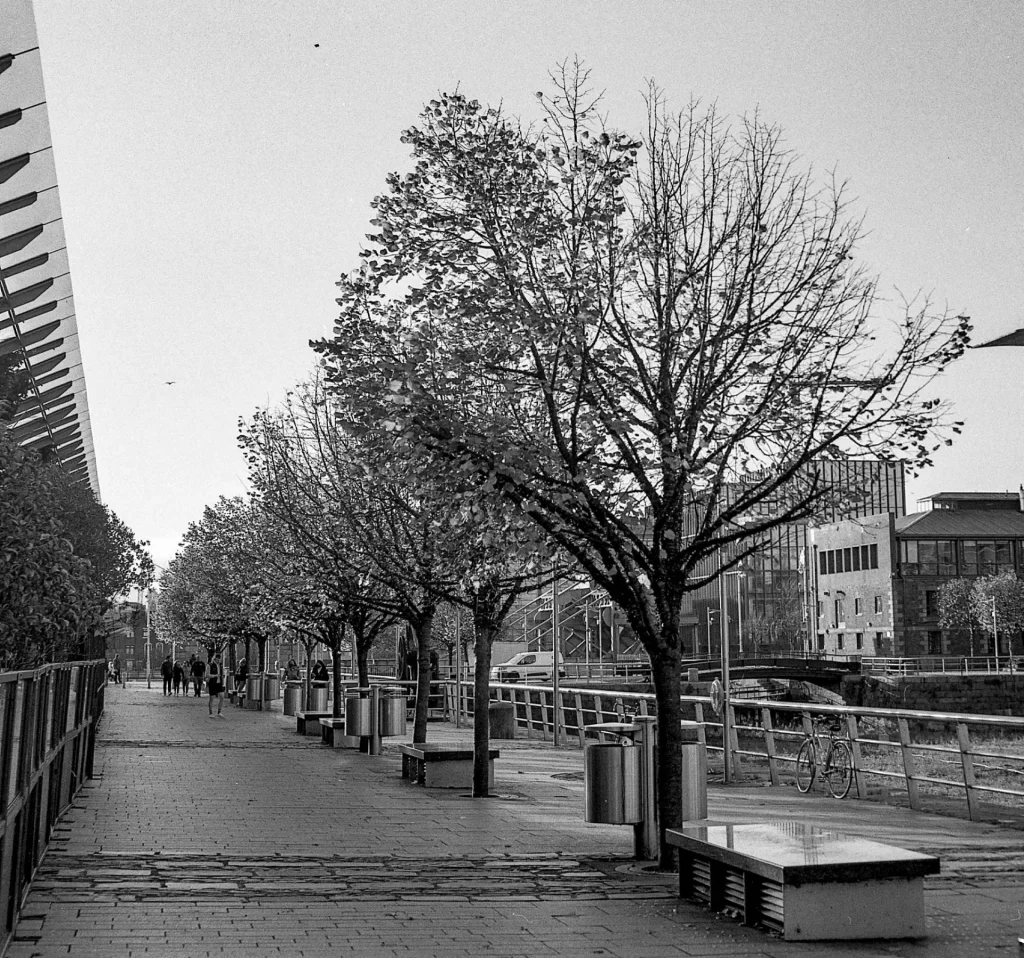
My next issue was how to set the exposure correctly and I had a number of options – use my DSLR, rely on sunny 16 (which I had never heard of before starting back with film), purchase a standalone light meter or use an app on the phone. I would love to have used my Dad’s Weston Meter, but despite trying to revive it by leaving open in gentle light for a few days, the selenium based mechanism was no longer functioning. I discounted use of the DSLR for pure convenience reasons and also discarded using Sunny 16, because I didn’t trust it (down to a lack of experience).
I then started looking at light meters and oh boy, there’s a rabbit hole to get lost in.
I looked at vintage combined light meters and range finders, modern 3-d printed shoe mounted meters, hand-held meters – both modern and vintage and also started looking at ones that could attach a spot-meter for landscape photography – and on and on and on……..I’m still looking at them ! To get going I went with an app called “Light Meter – Free”, which as the name suggests is available for €0. This is an excellent little app and I have managed to get pretty accurate exposures with it – I would highly recommend trying it before buying a meter (or as a prelude to buying a meter). You can even customise the setup for your particular camera to restrict to the particular apertures and shutter speeds available on your camera and save this as a profile in the app.
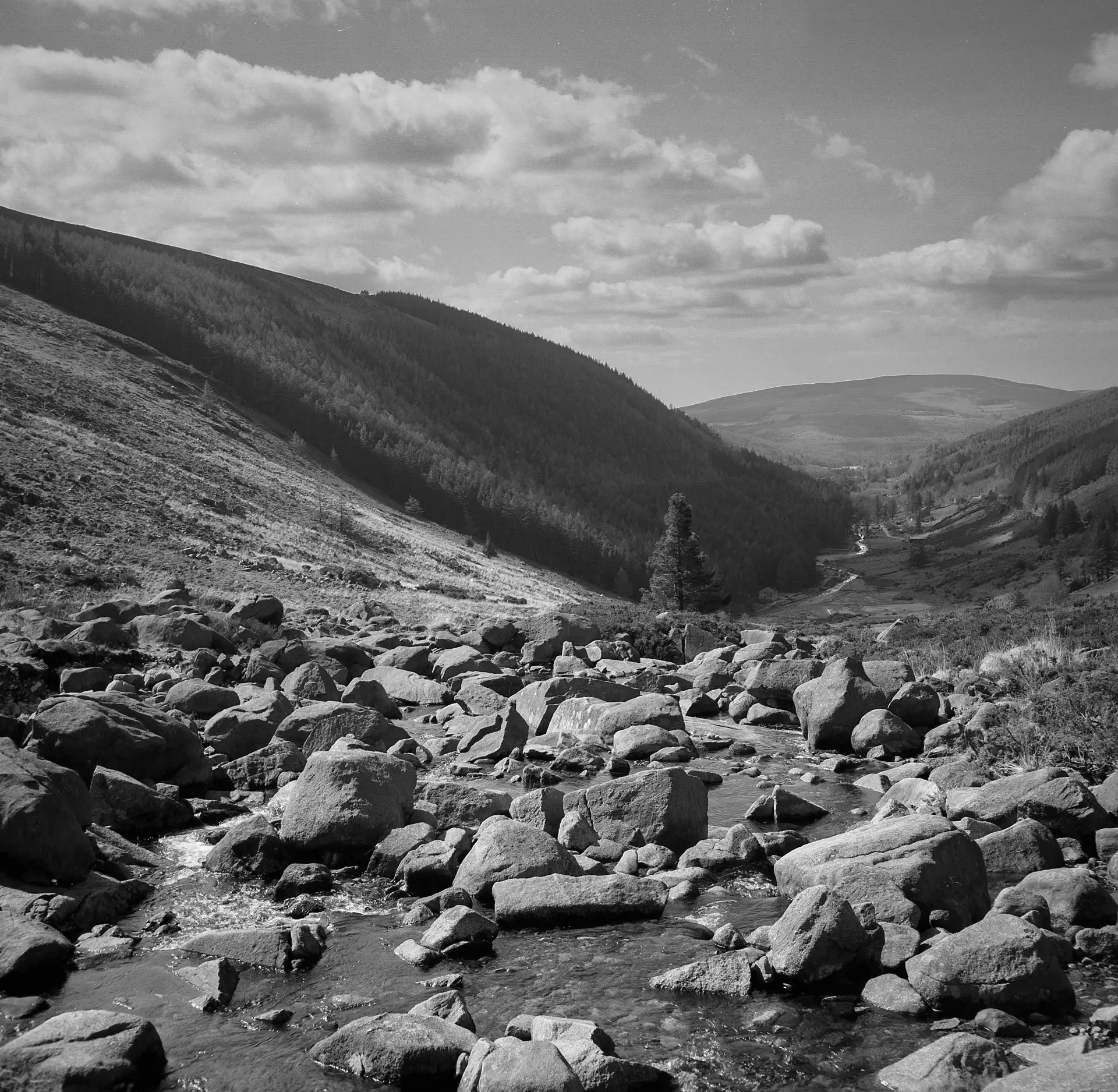
Now that the exposure conundrum was resolved, I turned to how to focus the camera without any visual means or rangefinder. Of course, you can maximise the depth of field by closing down the aperture and the manual helpfully points out that you can use the “Zeiss red dot setting” which “enables the IKONTA III owner to take rapid snap shots. Set the diaphragm lever and the distance setting mark on the red dots and everything from 13ft to infinity will be rendered sharply” . This would be fine, except, I wanted to really test out how sharp the lens might be wide open and I started using a tape measure to gauge distance between the film plane and the subject and setting the aperture to the maximum f3.5. This gives an insight to my over attention to detail and obsession with sharpness in my photography (which unfortunately often exceeds my pure enjoyment of the art and just taking shots for the sake of it). It gets worse unfortunately – I then got my hands on a laser distance measure (cheap and cheerful one) and started using that to set the focus. I’m happy to report that a few films later, I have gotten over myself and now just guess the distance and give myself some latitude with the exposure.
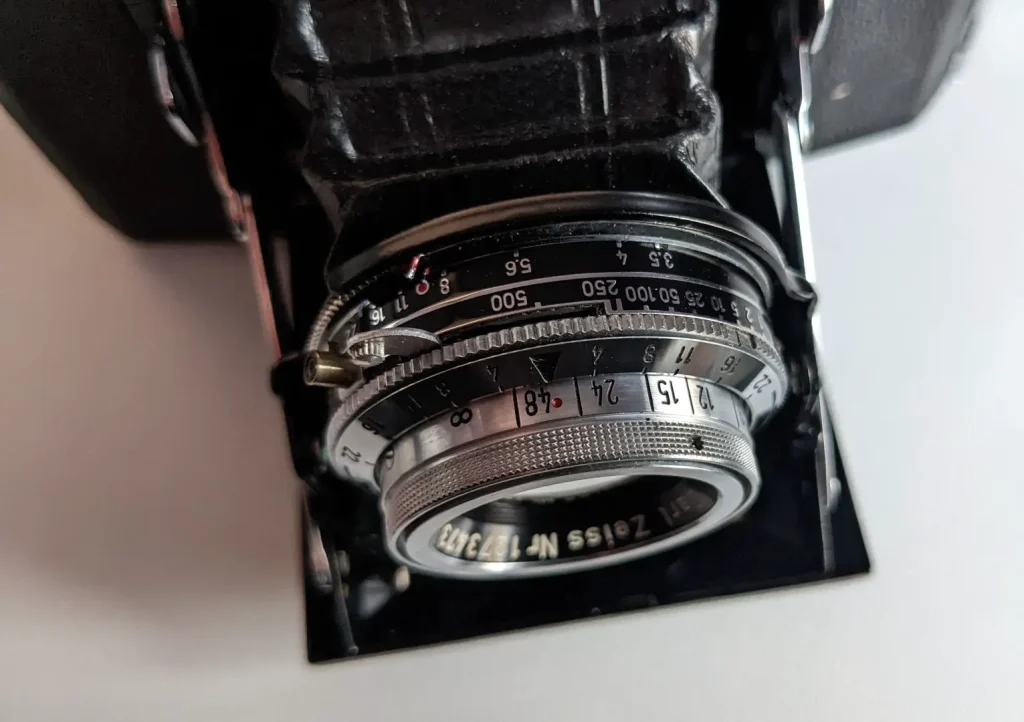
Now that I had extracted myself from the exposure and focus rabbit holes and shot a few rolls of film, I then went straight down another one looking at the accessory infrastructure available for the Zeiss.
I wanted to get my hands on a yellow filter to improve contrast for B&W and a lens hood to minimise flare. Googling “filters for Zeiss Ikon Ikonta Tessar”, you might think that there couldn’t be too many options (if any!) that would satisfy this criteria? Actually there are – because like today’s lenses, the different Zeiss lenses had different filter diameters and some were screw-on while others were push-on. I had to do quite a bit of research to figure out which type I needed and I even contacted Lee Filters to see if they might manufacture an adapter ring that I could use with my set of 100 system filters (because they say they consider bespoke requests on their website), but no luck on that front. After a good bit more research I eventually landed on trying out a Zeiss “model 353” – 35.5mm screw on yellow filter.
What puzzled me the most about this was that the lens did not appear to have any threads to receive the filter and only after a bit more research did I discover that Zeiss used an ingenious method of attaching filters. On inspection, the end of the lens looks slightly milled, but actually, it is designed to also accept filter threads. This was to allow easy grip of the lens to focus while still being able to attach filters. I was getting more and more impressed with the technology, design and engineering of these cameras. I then started looking at the lens hood I needed, which was a model “1111” 32mm push on hood – not the most elegant looking thing, but nevertheless – I wanted to try one out. There were one or two available online, but I wasn’t willing to pay the money that sellers were looking for – between €50 and €100.
After looking for a while, I eventually came across a lot on eBay that included a 35.5mm screw on yellow filter, a “Proxar” close up lens (available in different magnification options, they enable a closer focusing distance than the 3.5ft….. and yet another rabbit hole opens up!), an Icoblitz flash, a “1111” lens hood in its leather case and, oh yes I nearly forgot, a Zeiss Nettax 120 film folding camera from the late 50’s in close to mint condition with its original box and receipts – all of this cost me €50 !
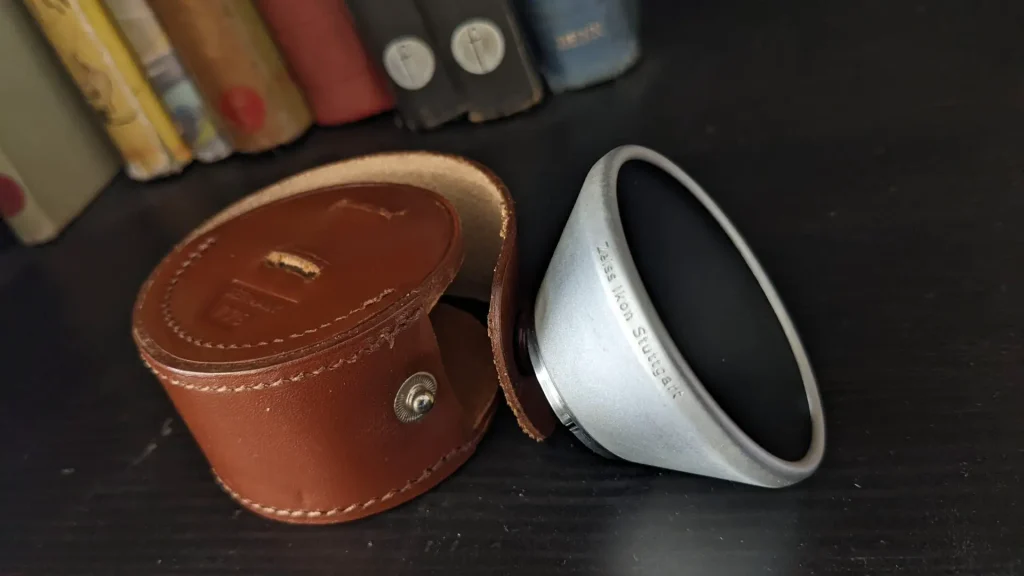
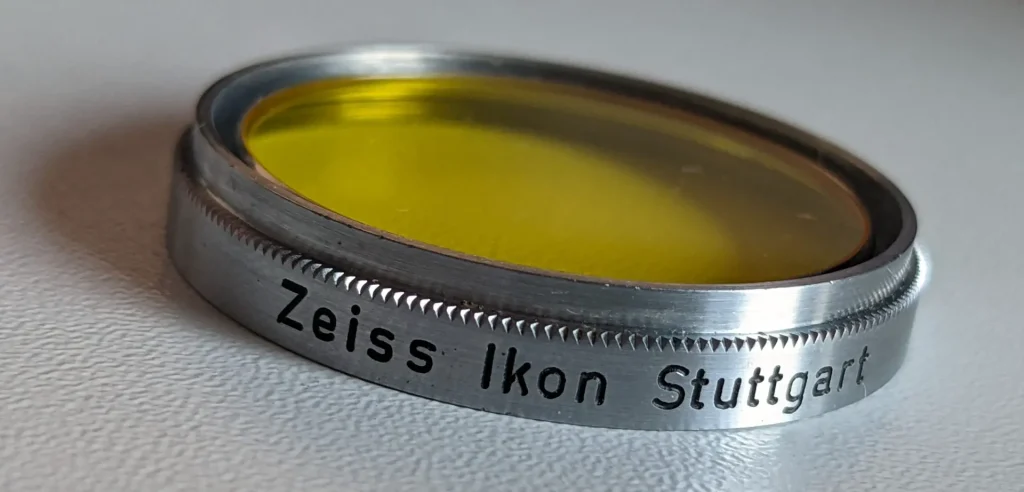
I have shot about 5 rolls of film on the Zeiss and am only now starting to get used to it. It is not an easy camera to use by any means but with a bit of practice, it can be mastered.
To load the film, it would be handy to have a 3rd hand, or even a 2nd pair of hands as you wrestle with trying to get the film and backing paper to catch on the take-up spool.
Rolling on the film requires opening the little silver film window cover on the film door and then carefully winding on the film while watching for the next number on the roll to appear in the dark red window. More than once, my ailing eyesight has led me to wasting one of my 12 shots as I roll past a negative by mistake. Accidental double exposures are prevented as the camera has a “built-in shutter release locking mechanism” – this is handy except for the fact that if you wanted to try multiple exposures, the camera won’t allow you.
More than once, I have completely forgotten to focus the camera, which sounds basic until you remember that according to the viewfinder, everything is in focus ! On the subject of the viewfinder, it is a tiny square window through which to view the subject and does not represent exactly what you get on your image because of parallax issues. This requires you to ensure that you leave a bit of latitude in framing the picture to ensure you get everything in.
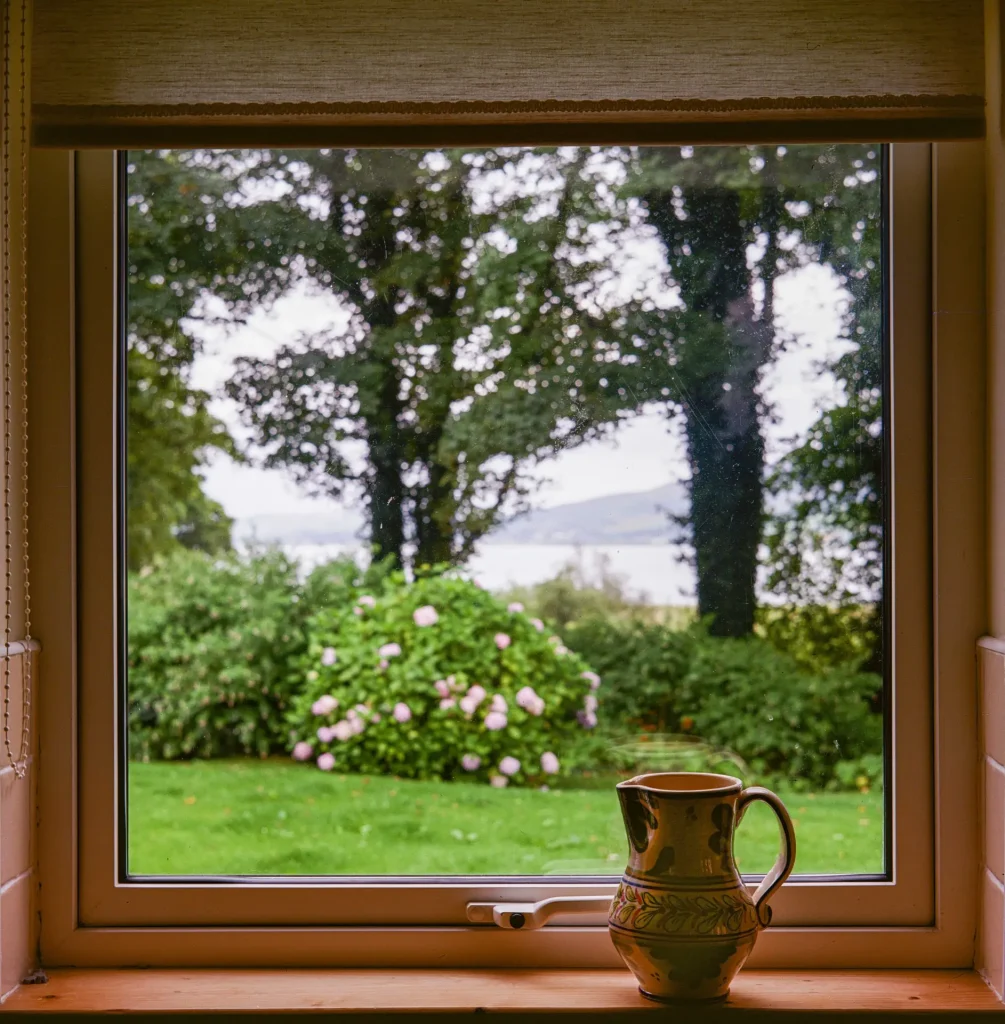
Lining up leading lines into the corner of the frame is an interesting challenge !!
Ok – so the camera is not all that easy to use, but I don’t care – the positive experience of using the camera far outweighs its limitations and in fact, drive me to use it more and more because of the challenge of getting a good shot. People talk about moving back to film because of the different experience to digital. Moving further back in time with one of these cameras is a whole different experience again. There’s really no such thing as taking a snapshot. Yes – you can use the “red dot” setting to maximise depth of field and in consistent lighting, you can probably get away without checking the exposure….but, I have found that you need to spend time on each shot to get good results out of it – and that is the whole point of using this camera in the year 2022. I might go out shooting with just this camera for a couple of hours and still be on the same roll of 12 shots when I get back home and that’s absolutely fine with me! Even taking care with each shot, I’m happy to get one or maybe two decent shots out of a roll. Processing the negs myself is a further enhancement of the experience as you are responsible for the output from cradle to grave. You need double the chemicals to process one roll of 12 shots vs a 36 shot roll of 35mm film, but the quality of the negatives you get at the far end is worth it – yet another factor that forces you to take your time when using this camera.
I haven’t gone back to darkroom printing (yet!). I still have all my Dad’s equipment – enlarger, trays etc, but they remain in storage for the moment. Instead, I’m scanning on an Epson V600 which scans 120 as well as 35mm negs and does a pretty good job on it too. Colour processing is also a step too far for me at the moment and I use a lab to process and scan these for me.
If you are interested in trying out medium format photography but don’t want to make the significant investment required to buy one of the more recent medium format cameras – Mamiya, Pentax, Fuji etc , and you can deal with the challenges I have detailed above, I can highly recommend trying out one of these Zeiss cameras. There’s still plenty of them out there and provided you don’t go for a “Super Ikonta” , there’s good value to be had – provided you do your research on the model you want and check out the condition of the camera and lens before you buy.
I hope you have enjoyed (or even made it to the end) of the meandering history of my Zeiss Ikon Ikonta and re-booting my use of the camera after a 27 year gap.
Share this post:
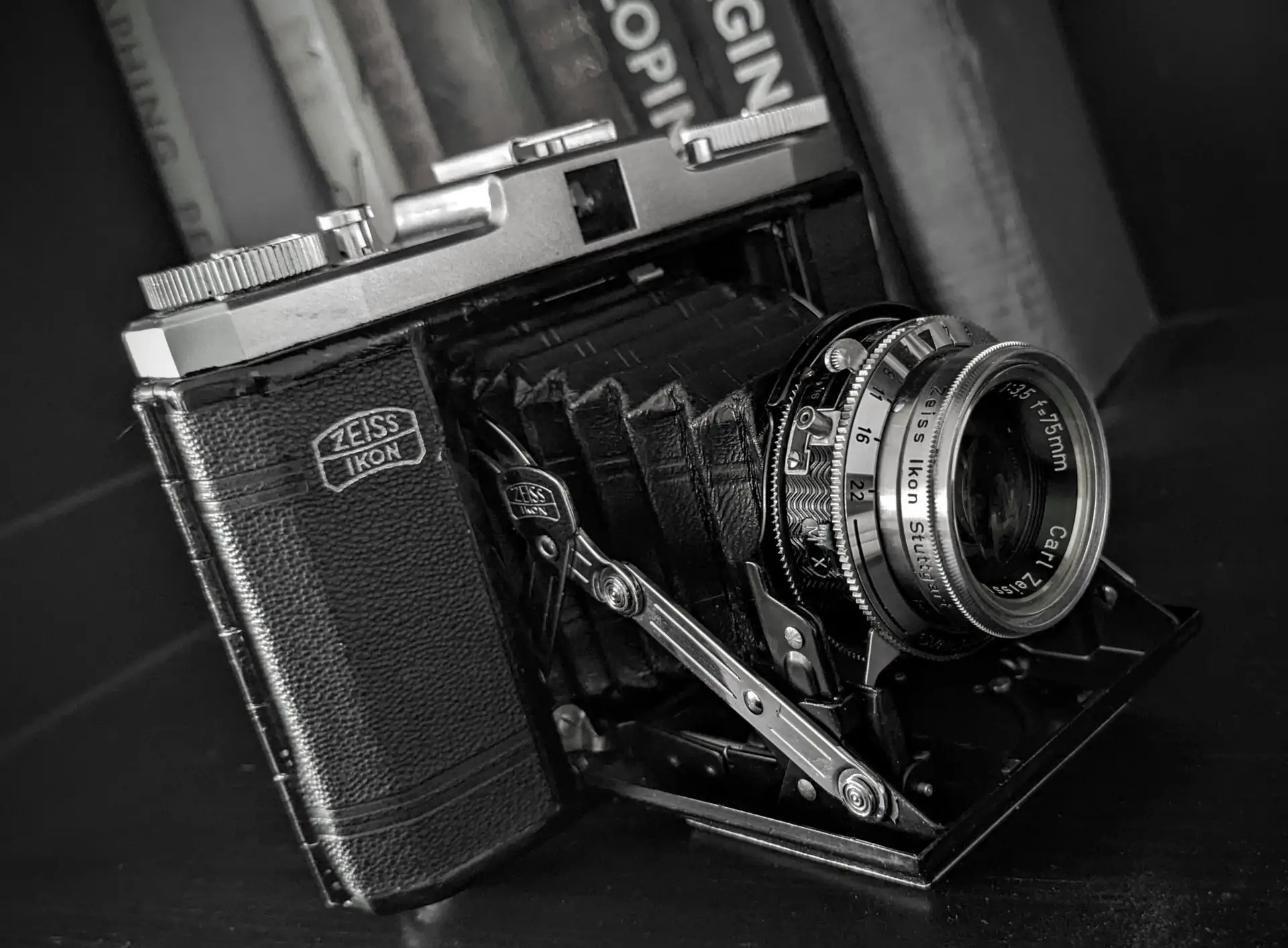








Comments
andy hertig on Zeiss Ikon Ikonta – Lost and Found, a 70 Year History – By Conor O’Brien
Comment posted: 25/04/2022
Fantastic story, excellent pictures - including the old photo of your mother - the negative survived well.
And yes, your thoughts at the beginning - it would really make a lot of sense to design valuable objects and machines again, which also last a long time - that would probably be the best environmental protection ever.
But probably the industry is not interested in it - throwing away probably brings more sales.
Luckily I also have a couple of bellows cameras; they are so easy to take with you and still offer an ingenious picture quality thanks to the 120 film.
Greetings from Switzerland, Andy
Comment posted: 25/04/2022
Comment posted: 25/04/2022
Comment posted: 25/04/2022
Ralph Turner on Zeiss Ikon Ikonta – Lost and Found, a 70 Year History – By Conor O’Brien
Comment posted: 25/04/2022
He always rued the day he let go of the Zeiss. The Trip is a great camera, but that big neg..
Great pics. Thanks for sharing ????
Comment posted: 25/04/2022
Brett Patching on Zeiss Ikon Ikonta – Lost and Found, a 70 Year History – By Conor O’Brien
Comment posted: 25/04/2022
Comment posted: 25/04/2022
Stephen Dennis on Zeiss Ikon Ikonta – Lost and Found, a 70 Year History – By Conor O’Brien
Comment posted: 25/04/2022
Thanks again.
Comment posted: 25/04/2022
Bill Brown on Zeiss Ikon Ikonta – Lost and Found, a 70 Year History – By Conor O’Brien
Comment posted: 25/04/2022
I think modern photography is moving towards a different audience or type of person. I have no interest in all the bells and whistles. Your Ikonta does what it's supposed to do and does it well, with an engaged operator manning the settings. Yes I get the low light capabilities of digital among other things but I just concentrate my efforts towards those shots that I can get. Friends looking through my photo portfolios aren't interested in the device I used but the image itself.
I am so glad you were able to reconnect with this camera. You are continuing the legacy that began when your dad pressed the shutter release for the first time all those decades ago. Keep up the great work.Cameras, negatives and film; a lasting legacy. I absolutely love that opening shot of your Mum!
Comment posted: 25/04/2022
Alex G on Zeiss Ikon Ikonta – Lost and Found, a 70 Year History – By Conor O’Brien
Comment posted: 25/04/2022
Also, I bought an Agfa Isolette recently and damn, folders are cool. During my first film days (98-‘04ish) I wasn’t really even aware these existed. No one I knew talked about them. Maybe because Kodak with the 620 rollfilm dominated the US market?
Comment posted: 25/04/2022
Michael Greene on Zeiss Ikon Ikonta – Lost and Found, a 70 Year History – By Conor O’Brien
Comment posted: 25/04/2022
I acquired a Super Ikonta 531/16 during covid from a friend. He was a bit of a tinkerer and I think he "Over fixed" the camera. Shot a few rolls and found it to not be sharp. I have been meaning to have it serviced and hopefully brought back up to spec, but it has been sitting in the drawer. Your article reminded me that I need to get it working again, and that if properly repaired, will likely be back to creating super sharp images once again. I reached out to a repair person this morning and will be sending it in this week.
The images you posted are wonderful. Thanks for the article and the nudge to get mine going again. I hope you get a lifetime of fantastic images from your camera.
All the best,
Michael Greene
Comment posted: 25/04/2022
Comment posted: 25/04/2022
Carlton O. Phelps on Zeiss Ikon Ikonta – Lost and Found, a 70 Year History – By Conor O’Brien
Comment posted: 25/04/2022
Comment posted: 25/04/2022
Jay Dann Walker in Melbourne on Zeiss Ikon Ikonta – Lost and Found, a 70 Year History – By Conor O’Brien
Comment posted: 26/04/2022
I've owned the Ikonta's poor relation, the Zeiss Nettar, since 1980. Mine is a circa 1950 model with the much-maligned (but very useful) direct viewfinder. It takes 12 6x6" images like the Ikonta, uses the same Zeiss accessories, and usually comes with a Nova 80mm f/4.5 or a more limited (but still entirely useable) f/6.3 for the budget buyers.
More importantly, it folds nicely and neatly to fit in a pocket, and it can be carried easily into the field, even on bush treks or more strenuous hill/mountain climbs. I have an early '50s Weston Master III which amazingly still works, hangs well round my neck and does everything it was intended to, at least in daylight.
The quality those small folding cameras are able to produce, with a little care in use and some experience with basic cameras, is truly amazing. My Rolleiflexes still do most of my MF work, but the Zeiss, with its companion (a Voigtlander Perkeo I with an 80mm f/45 Collar Skopar and a Synchro-Compur shutter (both expensive options in their day, like the Zeiss Tessar on that Ikonta) is no slouch in the sharpness market...
I do like the term "zero technology" and I will be using it in discussions with those few remaining old members of our photo club - an "ancient's group" of three of us who meet every now and then at a good cafe in the Victorian (Australia) Goldfields where I now live in retirement, for a nice feed, some good Pyrenees red wine, and a lot of nostalgic memory-sharing.
Good one, Conor!! As usual. You are always eminently readable and your writing is most enjoyable to me. Again, thanks.
From Dann in Melbourne
Comment posted: 26/04/2022
benjamin amberg on Zeiss Ikon Ikonta – Lost and Found, a 70 Year History – By Conor O’Brien
Comment posted: 26/04/2022
I have a Zeiss Super Ikonta 531/2...which I've had for years...the pictures are fantastic...when I can get it to properly focus...there's some issues with the rangefinder...I think...I've had a hard time assessing the problem...I've run many a roll through it with varying degrees of success and failure...I've taken it to the local shop with the same results...which is a shame, because when it hits, it hits hard!
I've inquired at the local shop about having it looked it, but they are at a loss as to who might even be able to work on it...I'm in Portland, Oregon...does anyone here have any suggestions as to who might be able to have a go at tuning the thing up?
Comment posted: 26/04/2022
Comment posted: 26/04/2022
Brian Cox on Zeiss Ikon Ikonta – Lost and Found, a 70 Year History – By Conor O’Brien
Comment posted: 26/04/2022
Comment posted: 26/04/2022
Lee on Zeiss Ikon Ikonta – Lost and Found, a 70 Year History – By Conor O’Brien
Comment posted: 26/04/2022
Zeiss Ikon had 3 different "trim levels" of these folding cameras, if you will, Nettar, Ikonta, and Super Ikonta. The Ikonta was the mid-level trim which basically exempted it from the lowest spec lens and shutter combinations. But not very many Ikontas were made with the top-tier Tessar lens. Most had triplet f/4.5 or f/3.5 Novar Anastigmat lenses. Nor were too many Ikontas made with the top-tier Synchro-Compur shutter, which allowed for 1/500 top shutter speed. This means your father's (now your) 523/16 is a very high-spec version of this camera. Basically the only upgrade you would get by going with a top-trim Super Ikonta would be the built in rangefinder for focusing. My 6x9 Ikonta 523/2 is not a top-spec camera. It has a 105mm f/3.5 Novar Anastigmat lens with Prontor-SV shutter, giving me shutter speeds up to 1/250 sec, plus Bulb.
I love how shooting these cameras takes me back in time, both with the deliberate shooting experience and with how the images are rendered. I think using a camera that you're positive is the same one your father bought new in the 1950s will have even more meaning for you than just shooting with just any folding camera bought off Ebay. I'm really glad you found it after all these years and I hope you get many more amazing years of use and are able to pass it down to your offspring later on.
Comment posted: 26/04/2022
Troy Phillips on Zeiss Ikon Ikonta – Lost and Found, a 70 Year History – By Conor O’Brien
Comment posted: 26/04/2022
I too have this camera but with the 75mm f/6.3 lens . I purchased it with a pristine case at an antique shop for $25.
I hadn’t shot any camera much in years and this camera got me back into photography again.
I purchased a basics guide to photography teaching the exposure triangle. Then grabbed a few rolls of expired 120 film from local camera shop.
I cannot remember how I judged the lighting, probably the Sunny 16 Rule . But I shoot 3d archery and hunt besides being a carpenter and measuring all the time .
I guessed the distance to the subject and got every photo in focus and properly exposed.
I could not believe the image quality from this old camera. I was blown away to say the least. A few years later I got me a Nikon d7000 . Then a Nikon fe. Well that fe needed the Nikkor 28mm f/2.8 ya know .
That camera has now lead to a career in live music photography and mostly videography.
The thing is I still cannot get away from film . I now have 5 Nikon slr 35mm camera bodies and about 30 old lenses from 1960 until present in the F mount .
I also have the Fujifilm gs690 with the 90mm lens . Just purchased a copy of my first camera I bought as a 12 or 13 year old with a paper route. The Mamyia msx1000 and the 55mm f/1.4 lens . And about 5 other film cameras. I just love the feel and process of shooting film and with old works of art quality cameras.
I love the medium format cameras and want more. But I also have this thing about the feel of the small 35mm cameras with a light meter and their speed of use . I have the Nikon f5 now and am wanting the Leica M5 . That M5 may not be what most Leica folks crave but when I look at it , it speaks to me .
What a crazy addiction!
Comment posted: 26/04/2022
Gideon Smit on Zeiss Ikon Ikonta – Lost and Found, a 70 Year History – By Conor O’Brien
Comment posted: 26/04/2022
I owned some more film cameras before moving to digital, but in the last few years I'm back to using and collecting film cameras.
One of my most recent finds was a Zeiss Ikon Netter - the Signal version with the red flag in the viewfinder. A beautifully simple camera with only 3 speeds plus Bulb. I'm still on my first roll.
Comment posted: 26/04/2022
Henning on Zeiss Ikon Ikonta – Lost and Found, a 70 Year History – By Conor O’Brien
Comment posted: 27/04/2022
I started with an Agfa 6x9 folder (not nearly as classy) in 1953 when I was 8. My dad and grandfather were both into photography and my dad introduced me to developing and printing. The Agfa was also scale focussing and exposure guessing, mostly using the information printed with the film. My lifelong fascination with photography started there and has led me via TLR's, Leicas, many SLR's, 4x5's, 8x10's and others to architectural and commercial photography and much else. I still have many film cameras which I enjoy shooting with at times, but shooting with an old folder is special. Now of course most of my shooting is digital, and my enlarger (from the 1950's) is rarely used.
One thing I should note though is that developing a roll of 120 film takes exactly the same amount of chemicals as developing a roll of 36exp. 35mm film, because the areas of the films are the same. You might need more liquid in your tanks because the 120 film is wider, but the amount of active chemicals required is the same. Also pretty much the same as for one sheet of 8x10 film or 4 sheets of 4x5.
Comment posted: 27/04/2022
Michael Avison on Zeiss Ikon Ikonta – Lost and Found, a 70 Year History – By Conor O’Brien
Comment posted: 18/05/2022
I did not inherit a folder but decided I had to have one anyway (then I needed a second one). I love that you can fit a medium format camera in your back jeans pocket! I bought a Voigtlander Bessa off ebay and have run a few films through it. I have the same problem seeing the numbers in the red window! I wish Kodak would print them in bold. I have put a few results in Flickr album "120 film", I am squid57squid.
Recently I made my own lightmeter (https://www.instructables.com/Super-sensitive-Photographic-Light-Meter-Using-Ada/) it is not very compact I might make a compact version next, but it is probably more sensitive than any commercial one. Also immune to infrared. What I want to do next is make stereo pairs, so I bought a second Voigtlander and 2 rolls of film, Unfortunately with age my ability to use a simple stereo viewer has left me. So now I have to build a special viewer for older people as well! It turns out that the 120 format is just about ideal in size for stereo. We can have such fun with these old folding cameras! PS I am of course jealous of your Ikonta. The words Carl Zeiss .... special in photography. However for anyone thinking on these lines who wants a cheaper option, I am extremely happy with the image quality from my Voigtlander. I actually doubt anyone could detect any less quality than for a Zeiss. Heretical I know!
Comment posted: 18/05/2022